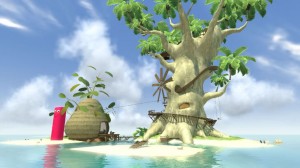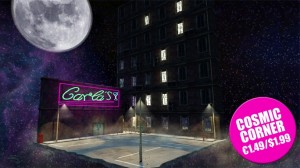Which Matters More in Home: Aesthetics or Functionality?
by NorseGamer, HSM Founder
So, those of you who saw LOOT’s livestream event during the recent AlphaZone 4 Expo were there for the dramatic unveiling of the nighttime Hollywood Hills House. And, let’s face it, it’s pretty remarkable: the new swimming feature for the pool, the built-in radio that plays music throughout the entire estate (and, like the built-in EOD, saves you a bunch of furniture slots), and the dramatic nighttime view across Los Angeles — right down to the animated jets coming in on final approach to LAX.
The very first question that came up, immediately: are there diurnal controls for the estate?
And the answer is no.
The reason why, without getting into too much technical detail: there are hard memory limits to what can be done with a scene in Home, and putting in diurnal controls would wreck the lighting. Hollywood Hills has some amazing lighting built into its nighttime scene — lighting which makes the estate feel very aesthetically realistic. Putting in diurnal controls in order to transition the same scene from day to night and back would result in a far less immersive nighttime environment.
 This doesn’t mean that diurnal controls aren’t a valuable (and oft-requested) feature; off the top of my head, three estates which are massively enjoyable as a result of it are Lockwood’s Dream Yacht, LOOT’s Sunset Yacht, and Heavy Water’s Avalon Keep. But there’s no question that compromises sometimes have to be made when trading functionality for aesthetics, or vice-versa.
This doesn’t mean that diurnal controls aren’t a valuable (and oft-requested) feature; off the top of my head, three estates which are massively enjoyable as a result of it are Lockwood’s Dream Yacht, LOOT’s Sunset Yacht, and Heavy Water’s Avalon Keep. But there’s no question that compromises sometimes have to be made when trading functionality for aesthetics, or vice-versa.
So this brings up the question: which is more important? Which will drive more people to open up their wallets? Aesthetics or functionality?
It’s certainly not a new question. HSM’s offered its own market guidance on the subject over the years. And if you look at how Home’s personal estates have generally trended, there’s been an overall evolution from “pretty box” settings to more and more bells and whistles. These things don’t necessarily need to be present, but as the marketplace becomes increasingly saturated, they’re one method of differentiating your product from the pack.
From my point of view, there are three levels of personal estate design, and each level represents an increasing order of complexity: aesthetics, interactivity and customizability.
Aesthetics are the most basic, but still absolutely critical. Aesthetics deal with how captivating you can make your scene look. Remember, what Home users are purchasing first and foremost is an emotional experience. And, generally, Home consumers — like other consumers in other social worlds — want relatable luxury. It has to be a scene that people want to spend time in and want to show off to their friends. Aesthetics have recently expanded to include background music as well as visual elements, which is indeed a welcome change.
 Interactivity consists of any elements which the user can interface with in the scene. This can range from simple elements such as opening a piece of kitchen cabinetry to very complex elements such as full-blown arcade games (Lockwood’s TankTop 1.0) or interactive media elements (LOOT’s EOD service). Interactive elements give users a reason to visit a space long-term, which help keep the “now what?” buyer’s remorse at bay. Indeed, there’s been a trend in Home to treat estates as unfolding games unto themselves — think Loco Roco’s MuiMui Island or Heavy Water’s Avalon Keep — which, while adding cost to a project, also help to drive up user retention levels and average user session lengths.
Interactivity consists of any elements which the user can interface with in the scene. This can range from simple elements such as opening a piece of kitchen cabinetry to very complex elements such as full-blown arcade games (Lockwood’s TankTop 1.0) or interactive media elements (LOOT’s EOD service). Interactive elements give users a reason to visit a space long-term, which help keep the “now what?” buyer’s remorse at bay. Indeed, there’s been a trend in Home to treat estates as unfolding games unto themselves — think Loco Roco’s MuiMui Island or Heavy Water’s Avalon Keep — which, while adding cost to a project, also help to drive up user retention levels and average user session lengths.
Customizability is the hardest level to pull off, but it’s arguably the most lucrative. Customizability, at its lowest level, is furniture items. This allows users to dress up a scene and personalize it. Beyond that, you’ve got the aforementioned diurnal controls and/or climate controls, leading up to entire elements of a space — walls, flooring, lighting, etc. — being offered in a range of styles for the user to pick from. Granzella tends to excel at this, as does Juggernaut. Indeed, the ultimate example of this would probably be nDreams’ brilliant Blueprint:Home, which is currently the ultimate in customizability–
–and also a perfect illustration of just how important aesthetics still are. Because when you hand a user a level editor, that’s frankly more work than some users are willing to put in. The user wants the hard part done for them: they want to buy a particular scene they emotionally relate to, which has highly detailed aesthetics, interactive elements, and as high a degree as possible of customizability in terms of picking from a wide variety of pre-designed templates.
 The question, of course, is what’s going to drive the most sales with the least amount of development cost. Because the more technically complex you make a project, the higher you have to raise the price in order to recover the associated costs. Building a Home estate with a ton of bells and whistles isn’t a cheap or short-term proposition: you’re tying up a lot of resources for several months at a time. Indeed, nDreams’ recent experiment with stripped-down, low-priced micro-estates is an interesting value proposition, because it really does raise the question of whether or not a user will choose to spend less money just to have a pretty setting, or if interactivity and customizability are now practically requirements for a chart-topper property.
The question, of course, is what’s going to drive the most sales with the least amount of development cost. Because the more technically complex you make a project, the higher you have to raise the price in order to recover the associated costs. Building a Home estate with a ton of bells and whistles isn’t a cheap or short-term proposition: you’re tying up a lot of resources for several months at a time. Indeed, nDreams’ recent experiment with stripped-down, low-priced micro-estates is an interesting value proposition, because it really does raise the question of whether or not a user will choose to spend less money just to have a pretty setting, or if interactivity and customizability are now practically requirements for a chart-topper property.
Is it enough to simply be able to enjoy a pretty scene, or has Home’s marketplace gotten so saturated with estates that these more complex levels of detail need to be added to a property in order to drive sales? Certainly, anyone who paid attention to SCEA’s top-ten sales lists (by number of units sold), back when that information was still being divulged to the general public, could plainly see that LOOT’s original Hollywood Hills estate was a bestseller, since it had that magical combination of relatable luxury and an interactive element — the EOD — which had never been seen in Home before. And now, with the nighttime version approaching — with swimming and play-everywhere radio built in, to say nothing of the jaw-dropping aesthetics — it will be very interesting to see how the market reacts. In particular, for club owners, it really is designed as the ultimate party pad: here’s an estate with a built-in radio and built-in EOD (which saves a ton of furniture slots), built-in swimming, and a setting which emotionally lends itself to entertaining guests. And judging from the preliminary consumer reaction so far, it looks like all of this will be well-received.
So now the question gets posed to you. What’s driven you, over the years, to pick up the estates you own? Which ones are you still using today? And what draws you back to them?
Share
| Tweet |



 LinkedIn
LinkedIn Twitter
Twitter
Good questions.
Personally, it’s mainly about the full package. How well rounded it is over all as to if I find a space “worth it” or not, example; the tropical island space (I forget it’s name) -- the one at sunset with the little open-walled house and the mini infinity pool at its front? Anyway, beautiful space, absolutely gorgeous! But, nothing more than a pretty box. No extra, space specific rewards, nothing interactive, as an MGS grunt would say “just a box” heh.
Then there’s LOOT’S Space Station (that comes pre-packed with furniture items) has the following; EOD (multiples of), Twitter feed, colour changable floors/lighting, windows that open/close, several floors, a STUNNING view of Earth, oh, and lets not forget the damn ROOF comes off!
Both of these are on polar ends to each other in what they offer the buyer. But then we get things like Darla’s Den -- for FREE! Okay, so Darla’s isnt really a patch on either but still, a trip to the Midway gives you instant access to your private slice of fairground.
Then we have that little Casino gem, also free and arguably pretty useless for decorating. But hey, it CHANGES! Constantly! So you never know what you might face anytime you walk in there. That, to me, is pretty cool -- and the price is right.
LKWD have set the bar however with not only their keen attention to detail and beautifuly textured spaces, but their systems are clever. By “systems” I mean things like the built-in gift machines and daily appearance rewards. Not only do their spaces look gorgeous, but they make you play a game of sorts for items that will not only benefit the space you just purchased, but there’s you own too. All they’re missing is their own version of EOD -- which is probably futile by now.
I guess what I’m saying is, everyone has their own standards and reasons for buying certain spaces. I know mine, and the price I’m willing to pay, but as for one influence or the other? Well, you can be the prettiest damn thing ever, but if you have nothing to contribute other than looks, how can you expect to get anything more from me than a long stare and a quick fling?
For me it has to do with a balanced combination of all of the above. Bramblenook farm pushed the envelope of all of these things and I bought it immediately. It continues to be a space that is a delight to visit. I am not really buying estates that much anymore as I have reached a saturation level for myself with them. I find I rarely if ever visit many of them and I can’t see adding another unless it has that special something I am attracted to, and that can vary depending on the points you have brought up.
The nDreams Aurora space that is on sale right now has peaked my interest, but it is because it is connected to the game itself and I think that is another perk that can attract people to buy.
Finding a balance is hard, and I imagine many developers have torn their hair out trying to figure out what people want anymore in this genre of purchases. I do believe that I will purchase the Hollywood club skin though, it looks fabulous.
I don’t think I can answer your title question. I’ve purchase estates just because they are beautiful (and I coveted them) and I’ve purchased estates that don’t appeal to me aesthetically, but have a game I want to play and offer to my friends. I’ve also purchased estates because I had an idea about decorating them that I wanted to try out.
I’d have to say that “Seven Winds” is my favorite space so far. It’s beautiful, can be customized and I can fly there, so what’s not to love?
Functionality is the most important. LOOT’s radios don’t work and they’re important to me. Without them and music, several of my apartment spaces are mostly useless and everything on HOME is on hold as to purchasing for me.
The way things look and are set up are important however that’s a matter of taste. As to functionality, several things in ACORN PARK don’t work but I’m happy going there so in that case aesthetics are important. Just gimme a pathway and grass and I’m set. (Aesthetics means the way things look? LOL)
Recently a friend said to me after BRAMBLENOOK came out, “That’s what you always wanted.” and yes they were right. Well, the park with a bridge too. The farm is amazing: grow crops, raise animals and try to get that darned bear out if the tree (I put the bear there). Imagination.
HOME TYCOON starts with with a field and a bridge we can’t access and after that we’re on our home as to customizability. Build a city, a race track or watch the grass grow. Our choice. Ah yes, winter Christmas houses also. Pretty great concept, eh?
We shall see on LOOTs night time apartment space. If the radios work then it’s probably a winner.
Some spaces I like but don’t like if they’re missing something. Leaving radios out, two examples are the scoreboard in the LONDON PUB which was on the blink but now works. Now if they can get the scoreboard working for the delightful GNOME CURLING spaces, both public and private, that would something.
When it comes to functionality, if it don’t work right, it takes away much of the fun. For me it’s the music. C’m LOOT, rock on with the music.
My first reply didn’t make it. It was long. This will be short. I’ll start the way I ended the first. LOOT, let the music rock on. Many of my spaces have little functionality without music, the radios.
Aesthetics are important. The park which along with a farm are something I long wanted. ACORN PARK doesn’t work well but just to be able to walk the path is enough. In this case the way it looks is the most important.
BRAMBLENOOK is special. Grow crops raise animals and trying the get the bear out of the tree. (I put the bear there.) It’s a fun place. Interactivity.
HOME TYCOON is what one wants it to be. Mostly grass, farms cities, villages, something we can build. Interactivity.
Little things mean a lot. In the LONDON PUB the dart scoreboard didn’t work and it took away from the space. Now it works and it’s much better. Functionality.
The delightful GNOME CURLING both public and private spaces are ruined for me by an improper working scoreboard. Maybe that too will be fixed. Functionality.
With me the most important thing is music. Others have their own thoughts of importance.
As an old song says, “To Each Their Own.”
Copy & paste your replies, folks, and hope you can the typing right. Replies are kinda’ like programming, eh?
OOPS! How did that happen. This is a case of double your pleasure double your fun doesn’t work.
 Keep the first and delete the next two. Could be worse. I might be a programmer.
Keep the first and delete the next two. Could be worse. I might be a programmer.